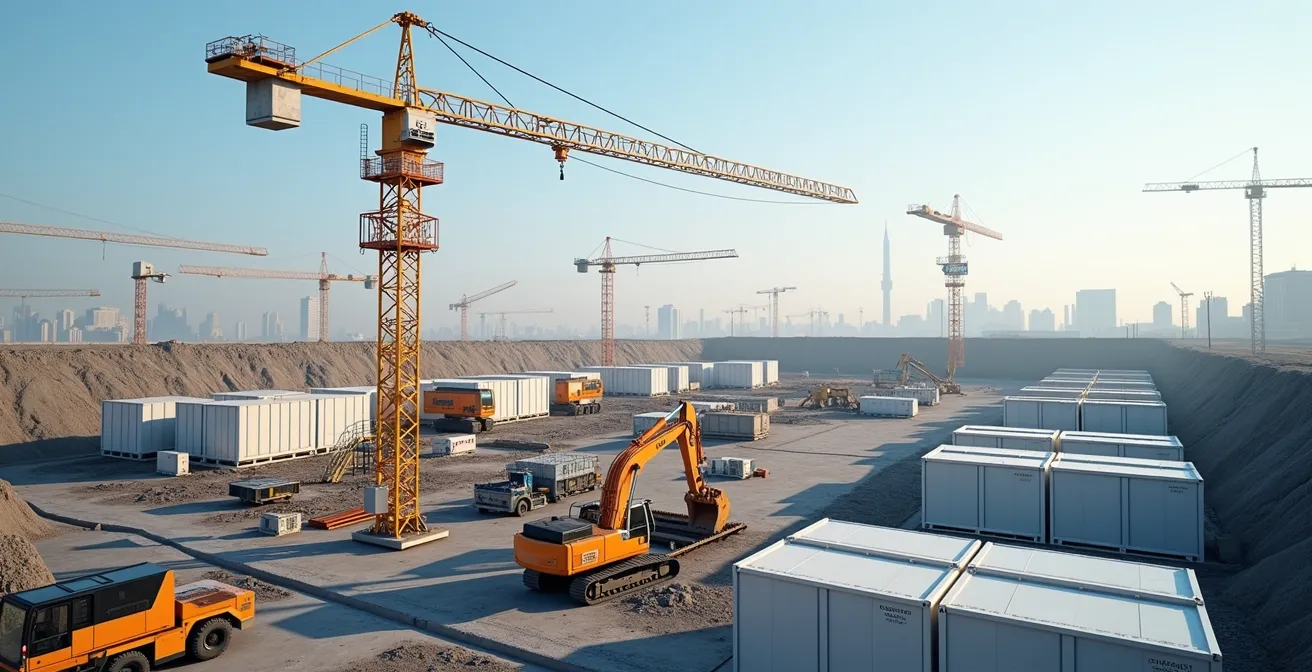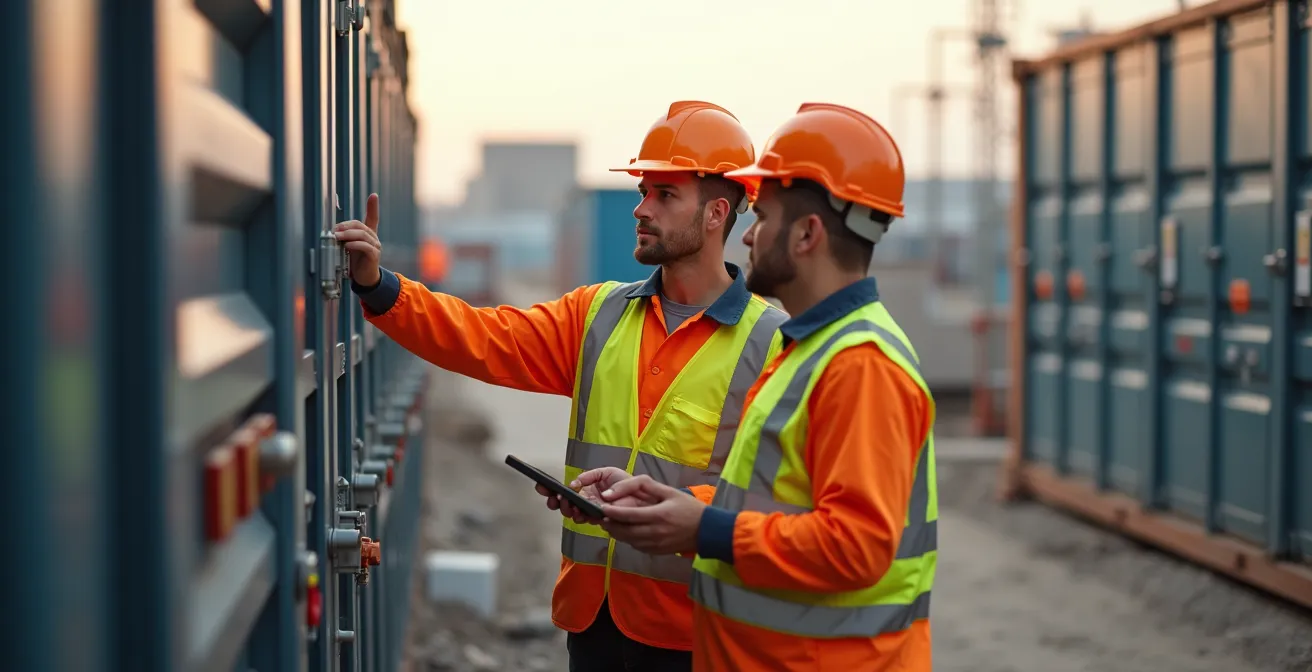
The familiar rumble of diesel generators has long been the soundtrack to construction sites worldwide. However, as the industry faces mounting pressure to decarbonize, project managers are increasingly tasked with finding viable, zero-emission power alternatives. The challenge is moving beyond broad concepts like “solar” or “batteries” to a practical, project-specific strategy. A successful transition is not about a simple one-to-one replacement; it demands a nuanced understanding of a project’s unique power demands, operational realities, and financial goals.
This shift requires a new way of thinking, focusing on matching the right technology to the specific job at hand. It involves looking beyond on-site emissions to the full lifecycle impact of a solution and implementing a phased transition that maximizes both environmental benefits and return on investment. Forward-thinking project managers now partner with specialized providers, such as the experts at eo-dev.com, to engineer and deploy these complex, next-generation power systems.
Key Power Alternatives at a Glance
- Decision Framework: Select technology (BESS, Hydrogen, Solar) based on your project’s scale, duration, and location.
- Lifecycle Impact: Understand the full carbon footprint, from manufacturing to recycling, to make credible sustainability claims.
- Phased Transition: Start with hybrid systems to dramatically cut fuel use before moving to a fully electric site.
- Comprehensive ROI: Calculate returns beyond fuel savings, including ESG value, carbon credits, and reduced maintenance.
Choosing the correct zero-emission power solution begins with a clear diagnosis of your project’s needs. Instead of a one-size-fits-all approach, a decision matrix based on key variables is essential. Factors like site size, total power demand (in kW), project duration, location, and grid accessibility will determine the most effective and cost-efficient technology.
This framework allows you to map your requirements to a specific solution, moving from abstract goals to concrete specifications. For instance, the power profile for a small urban infill project is vastly different from a large, remote infrastructure development.
| Project Profile | Power Demand (kW) | Recommended Technology | Operating Duration | Key Advantages |
|---|---|---|---|---|
| Small Urban, Short-term (< 6 months) | 50–150 kW | Battery Energy Storage Systems (BESS) | 6–8 hours per charge | Silent operation, minimal noise pollution, suitable for residential areas |
| Large-Scale, Long-term Urban (> 12 months) | 300–800 kW | Hybrid Solar + BESS | 8–12 hours battery + solar top-up | Lower operational costs, reduced grid strain, meets ESG targets |
| Remote, High-Demand Sites (> 12 months) | 500–2000 kW | Integrated Solar + BESS + HFC | Up to 17 hours (hydrogen fuel cells) | Fully off-grid capable, long operating times, zero on-site emissions |
| Heavy Machinery Intensive (cranes, drills) | 600+ kW peak | Hydrogen Fuel Cells (HFC) + BESS hybrid | 12–17 hours | High power density, rapid refueling (10–20 min), handles peak loads |
This strategic matching is already proving effective in pioneering cities. In Oslo, for example, a focus on electrification has yielded remarkable results. A recent report highlights that by 2024, 85 percent of energy used for machinery in Oslo’s municipal construction projects was emission-free; from January 1, 2025, all municipal construction sites are required to be emission-free. This demonstrates that with clear goals and the right technology mix, rapid progress is achievable.
Once you have a general technology profile, the next step is to engage with suppliers. An informed conversation is critical to avoid costly mistakes. Use a structured checklist to vet potential partners and ensure their solutions align with your operational realities.
- Peak load capacity: Confirm the system can handle simultaneous equipment operation without throttling or downtime.
- Recharging logistics: Verify charging infrastructure availability, grid connection capacity, and recharge time (especially for batteries vs. hydrogen refueling).
- Weather-proofing: Ensure equipment operates in site-specific conditions (cold climates may reduce battery performance by 30–40%).
- Maintenance protocols: Request detailed upkeep schedules and on-site support availability during peak construction phases.
- Scalability and flexibility: Confirm the system can be modified if project scope changes or phases expand.
- Lifecycle carbon footprint: Request third-party lifecycle assessment data (cradle-to-gate and end-of-life recycling plans).
A credible sustainability strategy requires transparency about the entire lifecycle of your power solution. While technologies like BESS and hydrogen fuel cells produce zero emissions during operation, their manufacturing, transportation, and end-of-life processing contribute to a total carbon footprint. Acknowledging this is key to building trust and making informed comparisons.
What is green hydrogen?
Green hydrogen is produced through electrolysis using 100% renewable energy, like wind or solar. It generates zero carbon emissions during its production, making it the most sustainable form of hydrogen.
When powered by a green grid, the lifecycle benefits are profound. For example, studies confirm that over their lifecycle, lithium-ion battery energy storage systems deliver 80–95% lower carbon emissions compared to conventional diesel generators when powered by renewable energy sources. The key is understanding the source of your electricity and the materials in your equipment.

The image above illustrates the material complexity of modern batteries. From raw material extraction to sophisticated recycling processes, the journey of each component contributes to the overall environmental impact. As manufacturing becomes more efficient and recycling rates improve, this lifecycle footprint will continue to shrink, further strengthening the case for electrification.
Similarly, not all hydrogen is created equal. The distinction between “green,” “blue,” and “gray” hydrogen has a significant impact on a project’s true sustainability. Understanding these differences is crucial for reporting and compliance.
| Hydrogen Type | Production Method | CO₂ Emissions (kg CO₂eq/kg H₂) | Carbon Capture | Sustainability Profile |
|---|---|---|---|---|
| Grey Hydrogen | Steam methane reforming (SMR) from natural gas | 9.3–12.3 | None | High emissions; fossil fuel dependent; unsustainable |
| Blue Hydrogen | SMR + Carbon Capture and Storage (CCS) | 7.6–9.3 | Partial (85–90% captured) | Lower emissions; transitional solution; limited CCS scalability |
| Green Hydrogen | Electrolysis powered by renewable energy (wind/solar) | 0.6–2.5 | Zero direct emissions | Zero emissions; fully sustainable; meets EU RFNBO criteria (< 3.38 kg CO₂eq/kg H₂) |
The choice of renewable source for producing green hydrogen also matters, as it directly influences the final carbon footprint.
Green hydrogen production using wind energy results in the lowest emissions at 0.6 kg CO2 eq. per kg H2, while solar energy results in higher emissions at 2.5 kg CO2 eq. per kg H2. Green hydrogen provides emission reduction of 80–95% compared to grey hydrogen.
– Royal Society of Chemistry, Climate Change Performance of Hydrogen Production
While no solution is perfect, the immediate operational benefits—such as the elimination of noise, NOx, and particulate matter—offer significant improvements to worksite safety and community relations. Coupled with ongoing advances in manufacturing and a growing understanding of the potential of reliable hydrogen energy, these technologies represent a clear path forward.
The idea of transitioning an entire construction site to zero-emission power can seem daunting. A pragmatic, phased implementation strategy is often the most successful approach. Instead of an “all-or-nothing” switch, begin by electrifying less-intensive applications like site compounds, offices, security, and lighting with Battery Energy Storage Systems (BESS).
For many projects, a hybrid model is the most practical and impactful first step. Pairing a smaller, optimized diesel generator with a BESS creates a highly efficient system. The generator’s sole purpose becomes recharging the battery during off-peak hours, rather than directly powering the site. This simple change can yield a dramatic reduction in fuel consumption, as a controlled comparison on an active site demonstrated a 69% reduction in fuel consumption when using a hybrid 60 kVA diesel generator paired with a 45 kVA/60 kWh battery energy storage system versus diesel-only operation.
| Operating Scenario | Generator Runtime (hrs/day) | Fuel Consumption (L/day) | Battery Charge Cycles (per day) | Operational Cost Reduction |
|---|---|---|---|---|
| Traditional Diesel Generator Only | 16–20 | 100–140 | N/A | Baseline (0%) |
| Hybrid: Generator + 45 kWh BESS | 6–8 | 30–50 | 3–4 | 65–70% reduction in fuel costs |
| Hybrid + Solar (10 kWp) Optimized | 4–6 | 15–25 | 2–3 | 75–80% reduction in fuel costs |
This phased approach allows teams to gain experience with new technologies while delivering immediate cost and emission savings. Real-world projects have successfully demonstrated the feasibility of even a 100% zero-emission site.
Sophies Minde, a 13,000 m² heritage renovation project in Oslo, achieved 100% zero-emission operations using an all-electric machinery fleet (excavators, wheel loaders, cranes, drills, pavers). As of June 2024, the project reduced emissions by over 200 tons of CO₂ equivalent. The electric fleet required 10–15% more units on-site due to charging downtime, but cost parity was achieved through lower electricity expenses offsetting higher lease costs. Batteries typically lasted 6–8 hours per charge with lunchtime charging; performance at -25°C showed 40% capacity reduction, though operations continued effectively.
The foundation of any successful transition, whether hybrid or full-electric, is a pre-project “Energy Audit.” This critical step involves mapping your site’s power usage patterns, identifying peak loads, and understanding daily consumption rhythms. The data gathered is essential for correctly sizing battery storage and planning a cost-effective, disruption-free implementation.
Key Takeaways
- Start with a project-specific decision framework to match technology (BESS, HFC, Solar) to your needs.
- Evaluate the full lifecycle carbon footprint, including hydrogen types, for credible sustainability claims.
- Implement a phased transition using hybrid models to immediately cut fuel consumption by over 60%.
- Calculate ROI beyond fuel, factoring in ESG benefits, carbon credits, and reduced maintenance costs.
The business case for zero-emission power extends far beyond fuel savings. A comprehensive Return on Investment (ROI) model must include a range of financial, regulatory, and reputational benefits. Meeting Environmental, Social, and Governance (ESG) goals can be a significant advantage in competitive tenders, particularly for green building certifications where up to 9 BREEAM credits can be achieved through lifecycle assessment and embodied carbon reporting. Other factors include potential revenue from carbon credits and avoiding fines in low-emission zones.
- 1. Direct Fuel & Energy Savings: Calculate the baseline diesel cost over project duration; subtract renewable energy operational costs (electricity rates); factor in maintenance savings (electric equipment has 30–40% lower maintenance costs).
- 2. ESG & Certification Value: Assign monetary value to LEED/BREEAM credits achieved; estimate tender advantage premium (typically 5–15% project value uplift for green-certified projects).
- 3. Carbon Credit Revenue: Calculate CO₂ emissions avoided; check local carbon credit markets (EU ETS, regional schemes) for potential revenue streams; document lifecycle savings for carbon accounting.
- 4. Regulatory Compliance & Penalties: Quantify costs avoided by meeting zero-emission zone regulations (low-emission zones, municipal mandates); estimate penalty avoidance in jurisdictions with emission fines.
- 5. Workforce Productivity & Health: Estimate reduced noise complaints, fewer health incidents (air quality, noise-induced hearing loss), and improved worker morale; factor in reduced project delays from community complaints.
- 6. Equipment Lease vs. Purchase Analysis: Compare operational leasing costs for electric equipment vs. diesel; include residual value for hybrid systems over multi-project deployments.
Finally, the transition to a greener site is as much about people as it is about technology. Site managers, electricians, and operators require new skills to manage battery systems, handle high-voltage equipment safely, and optimize charging logistics. Investing in training and upskilling is not an afterthought but a critical component of a successful deployment.

This human element—empowering teams with the knowledge to operate and maintain these new systems—ensures efficiency and safety. The benefits also extend directly to the workforce, creating a quieter, cleaner, and healthier work environment, which can boost morale and productivity.
By 2024, in Norway, electric construction machinery is predominantly leased, with costs for most electric models around 10% higher than diesel equivalents. However, project experience shows that for most mainstream machinery, lower electricity expenses offset the up-front price difference, making the overall costs of electric machines similar to diesel ones. Reduced greenhouse gas and air pollutant emissions, along with quieter and vibration-free operations, improve operator comfort and minimize disruption to the surrounding neighborhood.
– International Council on Clean Transportation (ICCT), Pioneering Zero-Emission Off-Road Machinery: Inside Oslo’s Sophies Minde Project
To navigate this evolving landscape successfully, project managers must explore innovative energy solutions and adopt robust planning tools. By combining the right technology, a clear financial model, and a well-prepared team, the zero-emission construction site becomes not just a possibility, but a competitive advantage.
Can electric machinery handle cold weather?
Yes, though performance can be affected. Real-world projects, like the Sophies Minde site in Oslo, operated electric machinery at temperatures as low as -25°C. They experienced around a 40% reduction in battery capacity but were able to continue work effectively by adapting charging schedules, such as charging during lunch breaks.
Is it more expensive to use zero-emission power on a construction site?
Not necessarily. While the initial lease or purchase cost of electric equipment can be about 10% higher than diesel equivalents, operational savings often lead to cost parity. Lower electricity and maintenance costs typically offset the higher upfront investment. Furthermore, a full ROI calculation should include the value of ESG credits, avoided fines, and increased tender competitiveness.
What’s the first step to transitioning my site to clean power?
The best first step is to conduct a pre-project “Energy Audit.” This involves mapping your site’s typical power consumption patterns, identifying peak load requirements, and understanding daily usage. This data is crucial for accurately sizing your power solution, whether it’s a BESS, a hybrid system, or another alternative.
Do I need to replace all my equipment at once?
No, an “all-or-nothing” approach is not required. A phased transition is often the most practical strategy. You can start by powering site offices, lighting, and compounds with a Battery Energy Storage System (BESS) or adopting a hybrid model that pairs a smaller generator with a battery to drastically cut fuel use before tackling heavy machinery.
